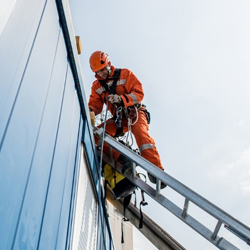Working At Height Legislation

What does working at height mean?
Working at height is defined as any work where a person could fall a distance that could cause injury or fatality. Working on a ladder or roof, a fragile surface, or close to an opening in the ground are all classed as ‘working at height’.
Working at height safety precautions
All members of staff who will work at height should receive working at height training. Staff should avoid working at height when they can, and only do it if it is extremely necessary. No member of staff should undertake to work at height alone, where possible – it’s always better to have someone else supervising and assisting.
What PPE should be used?
PPE should always be in excellent condition and should be well looked after and stored properly to ensure it is still suitable for use. The following PPE is sometimes used by employees in roles where they work at heights.
Hard hats
Vital for protecting the head from impact: whether that’s from falling objects or low beams and ceilings.
Important to protect the body from falls by clipping onto a safe object or part of the building. They will either restrict your fall or stop you from falling completely.
Fantastic for providing easier grip when carrying heavy objects or when climbing scaffolding or ladders.
Who is competent to work at height?
Anyone can work at height, but training is often required first. Any employees working from height should have plenty of experience in their role and should always be supervised by a colleague who has similar skills.
For shorter or lower-risk tasks, training can take place on the job, it doesn’t need to happen in a formal setting. For more complex tasks, a plan should be drawn up that is easy to follow.
Comments
Latest Blogs

An updated guide by consumer organization Which? looks at how to protect people’s ears. They focus on two main types of ear protection, earplugs and ear defenders.

A review submitted by the Department of Work and Pensions (DWP) has recommended that the Health and Safety Executive (HSE) should compel employers to improve their behaviour in issues of workplace health and safety.

Drivers are being urged to consider their footwear choices when behind the wheel, particularly during hot summer days when flip-flops are popular.

Leave a comment